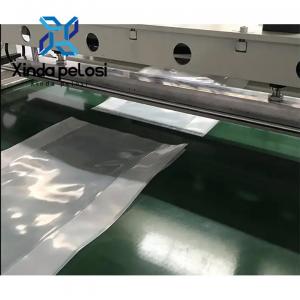

Add to Cart
Polypropylene PP Woven Bag Production Full Automatic Non Woven Bag
Making Machine
Model | XDP-700 | ||
Production speed | 40-120pcs/min | ||
Bag width | 100-800mm | ||
Bag length | 200-620mm | ||
Nonwoven fabric specfication | 30-120g | ||
Power supply | 220/380v | ||
Total power | 8KW | ||
Overall size | 8800*1850*1800mm |
PP/PE material or recycled materials > drying mixer > wire
drawing machine > winder > circular loom > bag cutting
machine > sewing machine > printing machine > PP woven bag
> baler
This machine special designed for non woven bag making. the machine
takes nonwoven as raw materials. It can produce nonwoven bags of
various sizes and shapes, such as nonwoven shopping bags,
reticules, flat port bags, clothing bags, shoes bags, and other
products packaging bags.
1.What are heavy-duty bags used for?
Heavy-duty bags are commonly used for packaging heavy or bulky
items such as construction materials, agricultural products,
chemicals, or industrial goods. They offer strength and durability
to withstand the weight and handling associated with these
applications.
2.What materials are heavy-duty bags made from?
Heavy-duty bags are typically made from robust materials such as
woven polypropylene (PP) or polyethylene (PE) fabric. These
materials provide strength, tear resistance, and puncture
resistance to the bags.
3.What is the difference between heavy-duty bags and regular bags?
Heavy-duty bags are designed to withstand higher loads and rough
handling compared to regular bags. They are made from stronger
materials and often feature reinforced stitching or additional
layers for added durability.
4.Can heavy-duty bags be customized?
Yes, heavy-duty bags can be customized with printing for branding,
product information, or safety labels. Printing options may include
company logos, product specifications, barcodes, or handling
instructions.
5.What industries commonly use heavy-duty bags?
Heavy-duty bags are used in various industries including
construction, agriculture, mining, chemical, food processing, and
manufacturing. They are versatile packaging solutions for
transporting and storing heavy or bulk items.
6.What sizes and capacities are available for heavy-duty bags?
Heavy-duty bags come in a wide range of sizes and capacities to
accommodate different applications. Common sizes include standard
sizes such as 25 kg, 50 kg, or 100 kg bags, as well as custom sizes
tailored to specific requirements.
7.Are heavy-duty bags recyclable?
Yes, many heavy-duty bags are recyclable and can be repurposed into
other products or materials. However, it's essential to check the
recycling guidelines and facilities available in your area to
ensure proper disposal and recycling.
8.What quality standards do heavy-duty bags adhere to?
Heavy-duty bags may need to meet specific quality standards and
regulations depending on their intended use and industry
requirements. Common standards may include ISO certifications, ASTM
standards, or industry-specific regulations.
9.How can I ensure the quality of heavy-duty bags?
Quality assurance measures such as rigorous testing, inspection,
and compliance with relevant standards are essential to ensure the
quality of heavy-duty bags. Working with reputable manufacturers
and suppliers who adhere to strict quality control processes is
crucial.
10.What factors should I consider when choosing heavy-duty bags for
my application?
Factors to consider include the type of product being packaged, the
weight and volume of the contents, environmental factors such as
moisture or UV exposure, transportation and storage conditions,
regulatory requirements, and cost considerations.
